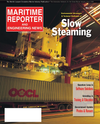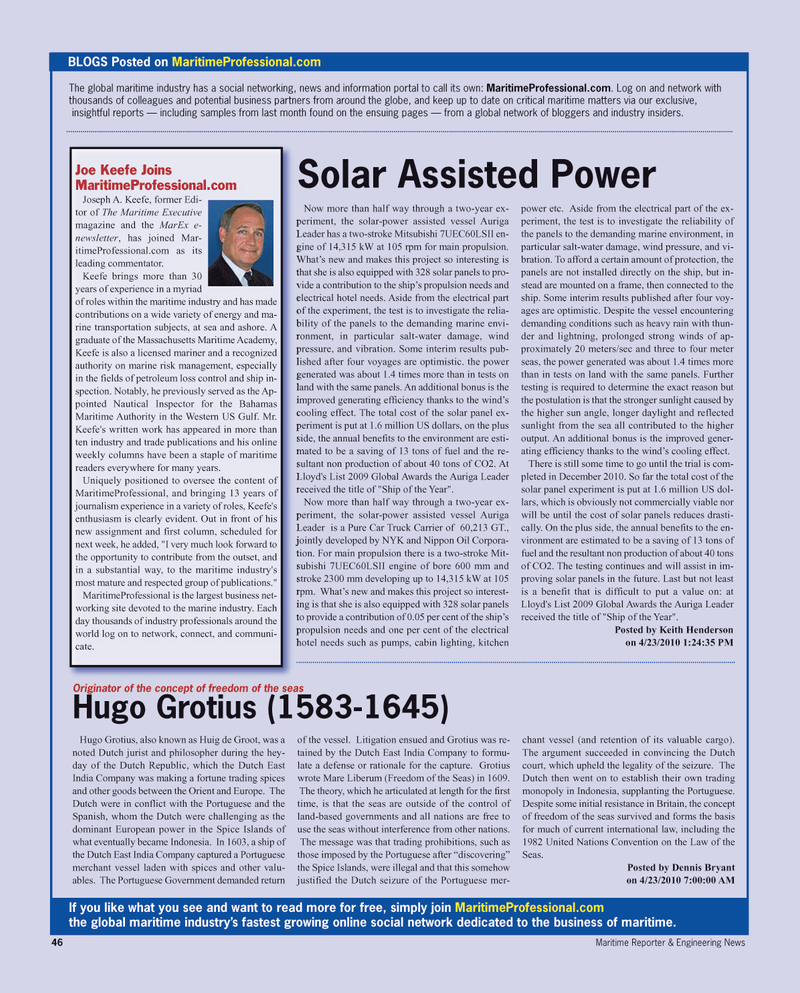
Page 46: of Maritime Reporter Magazine (May 2, 2010)
Read this page in Pdf, Flash or Html5 edition of May 2, 2010 Maritime Reporter Magazine
46 Maritime Reporter & Engineering News
The global maritime industry has a social networking, news and information portal to call its own: MaritimeProfessional.com. Log on and network with thousands of colleagues and potential business partners from around the globe, and keep up to date on critical maritime matters via our exclusive, insightful reports — including samples from last month found on the ensuing pages — from a global network of bloggers and industry insiders.
Now more than half way through a two-year ex- periment, the solar-power assisted vessel Auriga
Leader has a two-stroke Mitsubishi 7UEC60LSII en- gine of 14,315 kW at 105 rpm for main propulsion.
What’s new and makes this project so interesting is that she is also equipped with 328 solar panels to pro- vide a contribution to the ship’s propulsion needs and electrical hotel needs. Aside from the electrical part of the experiment, the test is to investigate the relia- bility of the panels to the demanding marine envi- ronment, in particular salt-water damage, wind pressure, and vibration. Some interim results pub- lished after four voyages are optimistic. the power generated was about 1.4 times more than in tests on land with the same panels. An additional bonus is the improved generating efficiency thanks to the wind’s cooling effect. The total cost of the solar panel ex- periment is put at 1.6 million US dollars, on the plus side, the annual benefits to the environment are esti- mated to be a saving of 13 tons of fuel and the re- sultant non production of about 40 tons of CO2. At
Lloyd's List 2009 Global Awards the Auriga Leader received the title of "Ship of the Year".
Now more than half way through a two-year ex- periment, the solar-power assisted vessel Auriga
Leader is a Pure Car Truck Carrier of 60,213 GT., jointly developed by NYK and Nippon Oil Corpora- tion. For main propulsion there is a two-stroke Mit- subishi 7UEC60LSII engine of bore 600 mm and stroke 2300 mm developing up to 14,315 kW at 105 rpm. What’s new and makes this project so interest- ing is that she is also equipped with 328 solar panels to provide a contribution of 0.05 per cent of the ship’s propulsion needs and one per cent of the electrical hotel needs such as pumps, cabin lighting, kitchen power etc. Aside from the electrical part of the ex- periment, the test is to investigate the reliability of the panels to the demanding marine environment, in particular salt-water damage, wind pressure, and vi- bration. To afford a certain amount of protection, the panels are not installed directly on the ship, but in- stead are mounted on a frame, then connected to the ship. Some interim results published after four voy- ages are optimistic. Despite the vessel encountering demanding conditions such as heavy rain with thun- der and lightning, prolonged strong winds of ap- proximately 20 meters/sec and three to four meter seas, the power generated was about 1.4 times more than in tests on land with the same panels. Further testing is required to determine the exact reason but the postulation is that the stronger sunlight caused by the higher sun angle, longer daylight and reflected sunlight from the sea all contributed to the higher output. An additional bonus is the improved gener- ating efficiency thanks to the wind’s cooling effect.
There is still some time to go until the trial is com- pleted in December 2010. So far the total cost of the solar panel experiment is put at 1.6 million US dol- lars, which is obviously not commercially viable nor will be until the cost of solar panels reduces drasti- cally. On the plus side, the annual benefits to the en- vironment are estimated to be a saving of 13 tons of fuel and the resultant non production of about 40 tons of CO2. The testing continues and will assist in im- proving solar panels in the future. Last but not least is a benefit that is difficult to put a value on: at
Lloyd's List 2009 Global Awards the Auriga Leader received the title of "Ship of the Year".
Posted by Keith Henderson on 4/23/2010 1:24:35 PM
Originator of the concept of freedom of the seas
Hugo Grotius (1583-1645)
Hugo Grotius, also known as Huig de Groot, was a noted Dutch jurist and philosopher during the hey- day of the Dutch Republic, which the Dutch East
India Company was making a fortune trading spices and other goods between the Orient and Europe. The
Dutch were in conflict with the Portuguese and the
Spanish, whom the Dutch were challenging as the dominant European power in the Spice Islands of what eventually became Indonesia. In 1603, a ship of the Dutch East India Company captured a Portuguese merchant vessel laden with spices and other valu- ables. The Portuguese Government demanded return of the vessel. Litigation ensued and Grotius was re- tained by the Dutch East India Company to formu- late a defense or rationale for the capture. Grotius wrote Mare Liberum (Freedom of the Seas) in 1609.
The theory, which he articulated at length for the first time, is that the seas are outside of the control of land-based governments and all nations are free to use the seas without interference from other nations.
The message was that trading prohibitions, such as those imposed by the Portuguese after “discovering” the Spice Islands, were illegal and that this somehow justified the Dutch seizure of the Portuguese mer- chant vessel (and retention of its valuable cargo).
The argument succeeded in convincing the Dutch court, which upheld the legality of the seizure. The
Dutch then went on to establish their own trading monopoly in Indonesia, supplanting the Portuguese.
Despite some initial resistance in Britain, the concept of freedom of the seas survived and forms the basis for much of current international law, including the 1982 United Nations Convention on the Law of the
Seas.
Posted by Dennis Bryant on 4/23/2010 7:00:00 AM
If you like what you see and want to read more for free, simply join MaritimeProfessional.com the global maritime industry’s fastest growing online social network dedicated to the business of maritime.
BLOGS Posted on MaritimeProfessional.com
Joe Keefe Joins
MaritimeProfessional.com
Joseph A. Keefe, former Edi- tor of The Maritime Executive magazine and the MarEx e- newsletter, has joined Mar- itimeProfessional.com as its leading commentator.
Keefe brings more than 30 years of experience in a myriad of roles within the maritime industry and has made contributions on a wide variety of energy and ma- rine transportation subjects, at sea and ashore. A graduate of the Massachusetts Maritime Academy,
Keefe is also a licensed mariner and a recognized authority on marine risk management, especially in the fields of petroleum loss control and ship in- spection. Notably, he previously served as the Ap- pointed Nautical Inspector for the Bahamas
Maritime Authority in the Western US Gulf. Mr.
Keefe's written work has appeared in more than ten industry and trade publications and his online weekly columns have been a staple of maritime readers everywhere for many years.
Uniquely positioned to oversee the content of
MaritimeProfessional, and bringing 13 years of journalism experience in a variety of roles, Keefe's enthusiasm is clearly evident. Out in front of his new assignment and first column, scheduled for next week, he added, "I very much look forward to the opportunity to contribute from the outset, and in a substantial way, to the maritime industry's most mature and respected group of publications."
MaritimeProfessional is the largest business net- working site devoted to the marine industry. Each day thousands of industry professionals around the world log on to network, connect, and communi- cate.
Solar Assisted Power

 45
45

 47
47
